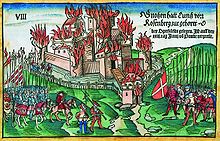Gnötzheim Castle
| Gnötzheim Castle | ||
|---|---|---|
|
today's granary |
||
| Alternative name (s): | Gnötzheim Castle | |
| Creation time : | around 1200 | |
| Castle type : | Niederungsburg | |
| Conservation status: | Tithe barn and round tower preserved | |
| Standing position : | Knighthood | |
| Construction: | no special features | |
| Place: | Martinsheim -Gnötzheim | |
| Geographical location | 49 ° 37 '0 " N , 10 ° 10' 59" E | |
|
|
||
The castle Gnötzheim was a castle - and later palace complex in Gnötzheim, now part of the municipality Martinsheim in the Lower Franconian district of Kitzingen in Bavaria . Individual buildings are still preserved today.
From the history of the place
In 1137 the place was first mentioned as heir of Willanzheim nobleman Gerung in a dispute with the Würzburg cathedral chapter and around 1300 it formed an office of the cathedral provost. Most of the place, however, belonged to the manor of the noble families von Seinsheim (1300 / 1327–1387), von Seckendorff (1390–1426) and von Rosenberg (1426–1632) before it came to the Counts of Schwarzenberg after their extinction in 1646 . From the castle, which was destroyed several times (1418, 1523, 1645 in the Thirty Years' War ), the tithe barn , built in 1562, and a round tower still stand .
The important Romanesque church from the 12th century was redesigned in the late Gothic and Renaissance style and still contains two Rosenberg tombstones from the 16th century. It served as the burial place of the Rosenbergs.
Destruction of the castle in 1523
In the middle of the 16th century, the robber baron Hans Thomas von Absberg kidnapped merchants from imperial cities in Franconia and Swabia on their trade trips and demanded a large ransom for their release. He had allies who supported him in his raids and hid him in their castles if there was a risk of capture. The Rosenbergs, at that time the owners of the Gnotzener castle complex, also supported him, as they hoped to be able to replenish their dwindling wealth a little. In 1523 the Swabian Federation finally sent its troops to level 23 " predatory nests ", including Wachbach Castle. On June 23, they reached the facility and blew it up to prevent the von Rosenbergs from returning.
The woodcut by Hans Wandereisen
The subsequently colored and inscribed woodcut by Hans Wandereisen says: “VIII. Gnotzen had heard from Cuntz von Rosenberg - located at Speckfeldt. Is on the .XIII. day Junij vo (m) Pundt verpren (n) t. “This view is the oldest representation of the castle, which is dominated on the section. Protected by a moat and a castle wall, the complex lies outside the village, of which there is no trace on the cut. A drawbridge leads through a small gatehouse to the inner castle gate, which is built into the castle wall. The latter shows a tower at each of the three visible corners. In the middle of the complex you can see the keep, which has an oriel tower in the upper half on each side. To the right and left of it the hall and other castle estates can be seen. The entire facility is on fire. The troops of the federal government consist of a good 70 horsemen in the left and around 50 mercenaries in the right half of the picture. In the middle two senior officers and a mounted captain can be made out.
The plant today
Parts of the castle are still clearly visible. The central massive building is the tithe barn , which is now used as a granary . A still identifiable chapel with a fresco and the size of the building suggest an originally integral part of the building as part of the castle. A nearby round tower is also well preserved from the outside . Traces of moats and experiences during construction work in the past provide further clues about the size of the castle.
The Bavarian State Office for Monument Preservation classifies the remains of the complex as a monument, while the underground remains of the castle are listed as a ground monument.





